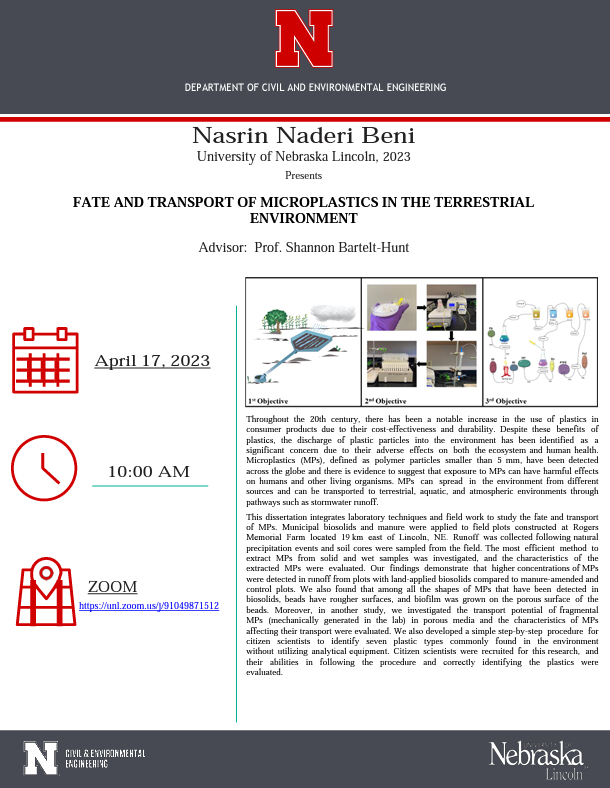
Nasrin Naderi Beni
University of Nebraska Lincoln , 2023
Presents
FATE AND TRANSPORT OF MICROPLASTICS IN THE TERRESTRIAL ENVIRONMENT
Advisor: Prof. Shannon Bartelt-Hunt
April 17 , 2023
10:00 AM
ZOOM
https://unl.zoom.us/j/91049871512
Throughout the 20th century, there has been a notable increase in the use of plastics in consumer products due to their cost-effectiveness and durability. Despite these benefits of plastics, the discharge of plastic particles into the environment has been identified as a significant concern due to their adverse effects on both the ecosystem and human health. Microplastics (MPs), defined as polymer particles smaller than 5 mm, have been detected across the globe and there is evidence to suggest that exposure to MPs can have harmful effects on humans and other living organisms. MPs can spread in the environment from different sources and can be transported to terrestrial, aquatic, and atmospheric environments through pathways such as stormwater runoff.
This dissertation integrates laboratory techniques and field work to study the fate and transport of MPs. Municipal biosolids and manure were applied to field plots constructed at Rogers Memorial Farm located 19 km east of Lincoln, NE. Runoff was collected following natural precipitation events and soil cores were sampled from the field. The most efficient method to extract MPs from solid and wet samples was investigated, and the characteristics of the extracted MPs were evaluated. Our findings demonstrate that higher concentrations of MPs were detected in runoff from plots with land-applied biosolids compared to manure-amended and control plots. We also found that among all the shapes of MPs that have been detected in biosolids, beads have rougher surfaces, and biofilm was grown on the porous surface of the beads. Moreover, in another study, we investigated the transport potential of fragmental MPs (mechanically generated in the lab) in porous media and the characteristics of MPs affecting their transport were evaluated. We also developed a simple step-by-step procedure for citizen scientists to identify seven plastic types commonly found in the environment without utilizing analytical equipment. Citizen scientists were recruited for this research, and their abilities in following the procedure and correctly identifying the plastics were evaluated.
More details at: https://unl.zoom.us/j/91049871512